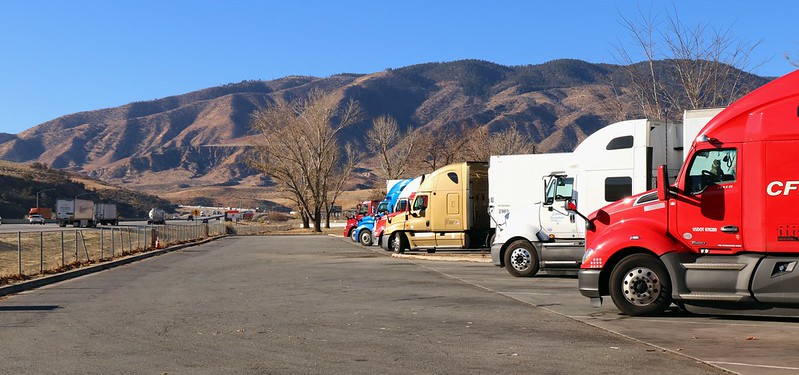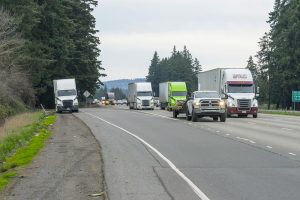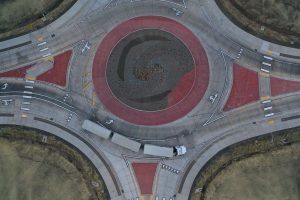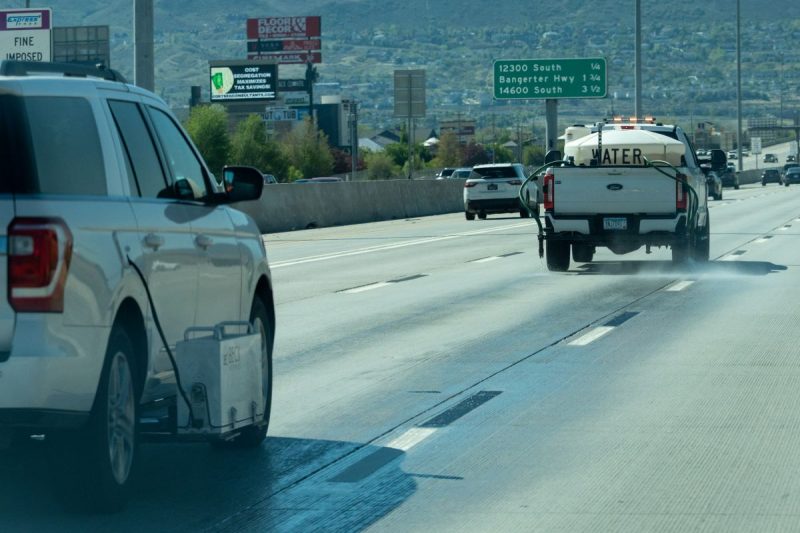 Thank You (25 Millions) Views, Flickr, CC BY 2.0
Thank You (25 Millions) Views, Flickr, CC BY 2.0The lack of safe truck parking is a concern across the United States, creating hazards for all road users. Unable to find a safe place to rest, fatigued truck operators may continue driving while tired or park on a highway shoulder or ramp to rest, where other drivers risk striking them.
The lack of truck parking with the amenities that drivers need—such as restrooms, showers, and hot meals—creates slow-downs and inefficiencies in the supply chain, increasing shipping costs and contributing to high truck-driver turnover in the labor force. Trucks parked on roadsides and ramp shoulders are also a nuisance to surrounding neighborhoods. Federal hours-of-service regulations mandate that truck drivers take breaks at specified intervals, creating a need for dispersed parking opportunities (e.g., somewhere to park every 50 to 100 miles) to enable drivers to maximize productive driving time.
Over the past decade, various TRB standing committees have examined truck parking through their specific subject matter expert lenses. In 2024, several standing committees—Intermodal Freight and Truck Transportation, Trucking Industry Research, Freight Transportation Planning and Logistics, Urban Freight Transportation, and Agriculture and Food Transportation—took an important step toward driving that conversation forward as one group at the 2025 TRB Annual Meeting.
Joint Session on Truck Parking
The joint session was designed to be not only informative but also interactive. It kicked off with a panel discussion of nontraditional solutions to meet the demand for truck parking. The three panel members discussed the following topics:
- Desiree Wood of the Nevada Department of Transportation and Real Women in Trucking, a nonprofit advocacy group, discussed how truck parking at major freight shipper and receiver locations could improve truckers’ and nearby neighborhoods’ quality of life;
- Becky Bradley of the Lehigh Valley Planning Commission in Pennsylvania discussed land-use policies recently enacted in her region to address truck parking demand created by new freight facilities; and
- Christopher Eaves of the Seattle Department of Transportation in Washington State focused on innovative approaches for the unique parking demands and constraints near ports—particularly for drayage vehicles (i.e., trucks that pick up freight from a seaport, railyard, or international border crossing and take it to a nearby warehouse).
The second half of the session focused on developing future research topics that cut across the sponsoring committees’ focus areas. Participants expressed a strong interest in addressing truck parking as a broader group and developed the following research questions to explore:
- What economic and policy structures contribute to truck parking shortages?
- Who is responsible for providing truck parking?
- What are the proven techniques for estimating truck parking demand?
- What are parking shortages’ economic, operational, and environmental impacts?
- What are the parking needs of overdimensional (i.e., oversize and overweight) vehicles?
- How do the needs of autonomous or alternatively fueled trucks differ from conventional trucks?
- How does the lack of parking near seaports affect operations?
- How can public and private sectors work together to address needs?
In addition, the group identified the following topics for examination:
- Truck-parking–generation factors for new developments;
- Best practices for estimating the benefits and costs of truck parking investments;
- Integrating truck parking into communities via approaches such as Complete Streets (i.e., making roadway rights-of-way available to all road users, such as pedestrians and cyclists) and curbside management;
- Innovative ways to mitigate the real or perceived negative impacts of truck parking facilities; and
- Quantification of the truck parking shortage’s impact on safety.
Moving Forward
One clear outcome of the joint truck parking session was the need to address this issue as one holistic, cross-cutting effort. Specifically, all research—on regulatory, safety, economic, data, and other topics—can be addressed holistically. By doing so, TRB could expand its capability to provide an impartial forum for the exchange of research, information, and data that helps private-sector stakeholders and public-sector policymakers understand the factors contributing to a lack of truck parking, as well as how best to evaluate them and develop solutions.







